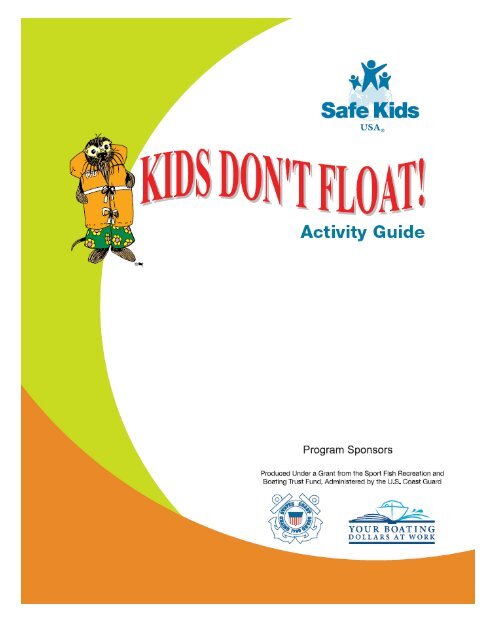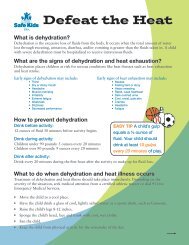Water Safety - Safe Kids Columbus
Water Safety - Safe Kids Columbus
Water Safety - Safe Kids Columbus
Create successful ePaper yourself
Turn your PDF publications into a flip-book with our unique Google optimized e-Paper software.
1. Introduction<br />
2. Activities<br />
Table of Contents<br />
3. Appendix A: Types, Proper Fit and Testing of Life jackets<br />
4. Appendix B: Putting on a Life jacket Correctly<br />
5. Appendix C: Open <strong>Water</strong> Fact Sheet
Introduction<br />
This activity guide has been developed by <strong>Safe</strong> <strong>Kids</strong> Worldwide to teach children ages 8<br />
and 14 about open water safety. The program should take 1-1½ hours to complete with<br />
each activity estimated to last 5 to 15 minutes. Ideally the activities should reach 10-25<br />
children at a time.<br />
List of Materials Needed:<br />
• Approximately 15 life jackets (varying sizes including adult).<br />
• 1 chair for each child (if not available, use benches or other seating)<br />
• A watch or clock with a second hand<br />
• Masking tape to outline the shape of a boat<br />
• Enough space for a relay race<br />
• 2 instructors<br />
• Examples of float toys, water wings, noodles, etc. (optional)<br />
Initial Set-Up<br />
Before the activities begin:<br />
• Ensure there are enough chairs/seats for every child.<br />
• For the introductory activity (“Got Life jacket?”), have life jackets placed on<br />
some of the chairs before the lesson begins. The total number of life jackets<br />
should be three or four less than the total number of kids participating.<br />
• The “Life jacket Drill” will require you to create a “boat,” with masking tape. It<br />
should be large enough to fit all of the children.<br />
• Look up your state’s law regarding life jacket use for children at the National<br />
Transportation <strong><strong>Safe</strong>ty</strong> Board website:<br />
http://www.ntsb.gov/recs/mostwanted/M_93_1_chart.pdf
1. Introduction: “Got a Life jacket?”<br />
Length: 5 minutes<br />
Objective: For children to learn the importance of there being a life jacket for every<br />
person on a boat.<br />
Materials: Approximately 15 life jackets (have 3 or 4 fewer life jackets than number<br />
of kids)<br />
Procedure: Place life jackets underneath the chairs around the room. As children<br />
enter the room, introduce yourself and explain that we will be learning about open<br />
water safety and life jackets. Next, ask them to locate a life jacket and sit down again.<br />
Remember that three or four children will end up without a life jacket to wear. When<br />
they are done have children throw all the lifejackets into the “boat.”<br />
Key Points to Discuss: Point out that certain children do not have lifejackets. The<br />
key message here is for the children to know that there should always be enough life<br />
jackets for everyone on the boat.<br />
2. Group Discussion<br />
Lead a class discussion to encourage children’s engagement.<br />
Length: 5-10 minutes<br />
Objective: To stimulate discussion among the children and informally “survey” them<br />
about their boating/open water practices. (This is important to gain a better idea as the<br />
educator about what is relevant to the children as it relates to open water safety).<br />
Procedure:<br />
Example discussion questions:<br />
• Where do you like to swim? Who do you go with (your parents, friends, etc.)?<br />
• What type of boats do you ride in? Do you boat a lot?<br />
• Has anyone ever fallen out of a boat or known someone who did?<br />
• Any scary experiences around the water?<br />
• Who should wear a life jacket?<br />
• Ask kids if they know if it’s the law for them to wear a life jacket while on a boat<br />
(http://www.ntsb.gov/recs/mostwanted/M_93_1_chart.pdf)<br />
Life jacket Laws<br />
__________________________________________________________________<br />
__________________________________________________________________<br />
__________________________________________________________________
3. Proper Life Jacket Fit Demonstration<br />
Explain how to select a life jacket that will fit properly.<br />
Length: 5 minutes<br />
Objective: To have children learn visually how to put on a life jacket and know how<br />
to perform the proper fit test.<br />
Procedure:<br />
1. Ask for one volunteer and have the child put on a life jacket. Show children how<br />
to put a life jacket on, making sure all the buckles/straps are tied or snapped from<br />
the chin down (it can be too big or too small). Explain that there are different<br />
types of life jackets although the most important thing to remember is any type is<br />
better than none.<br />
Fit Test<br />
i. Have the child raise arms above their head just like a referee signaling a<br />
touchdown. Then, pull up on the shoulders of the life jacket.<br />
ii. If the life jacket stays in place, it fits. If it touches his/her ears, it’s too loose.<br />
iii. Practice on the same child with different sizes until a proper one is found.<br />
2. If you have examples of other pool toys that are not life jackets, use this time to show<br />
them the difference between a water toy and a life saving device.<br />
4. Practice With a Partner<br />
Length: 10 minutes<br />
Objective: To have children learn how to select the proper life jacket and learn how<br />
to put it on correctly.<br />
Materials: As many different types of life jackets as you have placed in a pile.<br />
Procedure: Assign children to pairs and have each pair select a life jacket from the<br />
pile. Children should practice how to put on a lifejacket properly with their partner.<br />
Afterward, have children sit down and lead a group discussion with the following<br />
questions, highlighting the important points:<br />
Everyone should wear a life jacket on a boat or dock<br />
Fasten the life jacket straps from the chin down<br />
Group discussion:<br />
• How did you put it on?<br />
• Who should wear a life jacket?<br />
• When would you wear this life jacket?<br />
• What do you like about this life jacket?
5. Activity: Life Jacket Drill<br />
Length: 10 minutes<br />
Objective: To demonstrate why it is important that you properly wear a life jacket at<br />
all times when near open water, especially on a boat.<br />
Materials:<br />
• 1 chair for each child<br />
• Life jackets for half of the number of children participating<br />
• Masking tape to outline the boat, with an opening for an exit.<br />
Procedure<br />
Set up all the chairs in the masking tape boat. Divide the group in two halves,<br />
instructing one half to select and correctly put on a life jackets before entering the<br />
boat while the other half will board the boat and put their lifejacket under their chair.<br />
Announce a pretend emergency and give them up to 60 seconds to exit the boat<br />
wearing their life jacket (they are not allowed off the boat without their lifejacket).<br />
Key Points to Discuss:<br />
Point out that the kids with life jackets on were better prepared for the emergency on<br />
the boat. Explain that it can take as little as one minute for someone to drown.<br />
Therefore, it is important to put on a life jacket before getting into the boat and to<br />
wear it at all times when on the boat, rather than waiting for an emergency to do so.<br />
6. Activity: Life Jacket Relay Race<br />
Length: 15 minutes<br />
Objective: For students to practice and gain experience wearing a life jacket.<br />
Materials<br />
• 1 life jacket for each team<br />
• Space for a race<br />
• 1 adult checker for each team (to check the proper wearing of each kids’ life<br />
jacket)<br />
Procedure<br />
Divide the children into equal teams (about 5-6 kids each). Have them form lines.<br />
Place a life jacket at the feet of the first child in each line. At the signal to go, the first<br />
child in each line will pick up the life jacket, put it on properly, and run to the<br />
designated place where the adult is standing. The adult will quickly “inspect” the<br />
child’s life jacket, making sure the straps are tied and/or fastened and the life jacket<br />
fits snug. Let the children know that they can help each other put the life jackets on.<br />
The child returns to the starting point, removes the life jacket and gives it to the next<br />
person in line. The race is over when the first team to have each person complete the<br />
exercise is finished.
Key Points to Discuss<br />
Talk about how difficult it is to put on a life jacket when you are in a hurry.<br />
Emphasize that practice and becoming familiar with the proper size life jacket you<br />
need makes you a safer boater and/or swimmer. Also, point out that it is always easier<br />
to have the life jacket on to start with than having to put it on in an emergency,<br />
especially if the life jacket is stored away.<br />
Loaner Stations:<br />
Before the end of the event, tell the children about the life jacket loaner stations and<br />
how they can access them. Let them know where they are located so that they can<br />
share this information with their parents and friends.<br />
Wrap-up:<br />
Discussion<br />
• Did you have fun today?<br />
• What did you enjoy the most? Least?<br />
• What did you learn?
Appendix A<br />
Types, Proper Fit and Testing of Life jackets<br />
The following will provide you with background information on each topic discussed<br />
within the “Practice with a Partner” activity.<br />
There are many different types of Life jackets. These below are U.S. Coast Guard<br />
approved and will say on their labels.<br />
TYPE I, also called an OFF-SHORE LIFE<br />
JACKET<br />
• Keeps most people afloat by automatically<br />
turning them on their back<br />
• Can feel awkward and bulky to wear<br />
• Is not warm enough to offer protection from<br />
hypothermia<br />
• Is almost always orange<br />
TYPE II, also called a NEAR-SHORE BUOYANT-<br />
VEST, FLOATATION VEST, LIFE VEST, or<br />
LIFE JACKET<br />
• Can feel awkward and bulky to wear<br />
• Is not warm enough to offer protection from<br />
hypothermia<br />
• Come in a wide range of sizes and many life<br />
jackets for children are Type II life jackets<br />
• Comes in orange and other bright colors
TYPE III, also called LIFE VESTS and FLOAT<br />
COATS<br />
• Are usually comfortable to wear<br />
• Float coats keep the wearer warmer than life<br />
jackets or vests<br />
• Come in a wide range of sizes and many life<br />
jackets for children are Type III life jackets<br />
• Come in orange and a wide range of other colors<br />
Type IV such as LIFE RINGS and BUOYANT<br />
CUSHIONS<br />
• Are not substitutes for life jackets.<br />
• Should have a line or rope attached to them.<br />
• Come in orange, white and other colors.<br />
(adding a picture of “not approved items” such as<br />
water wings, inner tubes, noodles=none are substitutes<br />
for life jackets.
Appendix B<br />
Putting on a Life jacket Correctly<br />
Life jackets work best when they are correctly fastened. Consult a knowledgeable person<br />
if you are unfamiliar with the life jackets you are using. Specific guidelines for each of<br />
the life jacket types:<br />
Types I and II: Tie or snap all strap, working from the chin down.<br />
Secure the straps so the life jacket feels very snug.<br />
Type III: Zip all zippers and secure all snaps and straps.<br />
Snap any waist belts and pull them snug<br />
Tighten straps on the sides and shoulders so the life jacket fits<br />
securely.<br />
Put on crotch strap, if appropriate. (the tails of adult float coats are<br />
difficult to secure in the water.)
Appendix C<br />
Open <strong>Water</strong> Fact Sheet<br />
Key Facts<br />
• Each year, more than 830 children ages 14 and under die as a result of unintentional<br />
drowning. 1<br />
• On average, an annual 3,600 injuries occur to children due to a near-drowning<br />
incident. 2<br />
• Drowning is the second leading cause of unintentional death among children ages 1 to<br />
4 years and children 10 to 14 years. 3<br />
• As a child increases in age, so does their risk for drowning in open water settings. 4<br />
• In 2005, there was a reported 697 fatalities from boating accidents—approximately<br />
70 percent of the fatalities were due to drowning. 5<br />
• Moreover, 87 percent of those victims who drowned were not wearing a personal<br />
flotation device (PFD) or life jacket. 6<br />
• The fatal accident reports in 2005 estimated that 426 lives could have been saved if<br />
all boaters had worn life jackets. 7<br />
• Twenty-one children age 12 and under lost their lives while boating in 2005<br />
compared to 2004 where 14 children died in a reported boating accident. 8<br />
• In the summer, between May and August, drowning deaths among children increase<br />
89 percent over the rest of the year. 9<br />
Who<br />
• Male children have a drowning rate twice that of female children. 10<br />
• Black children ages 5 to 14 have a drowning rate three times that of their white<br />
counterparts. 11<br />
Effectiveness of Life jacket Use<br />
• From 1999 to 2003, it is estimated that 85 percent of boating-related drownings could<br />
have been prevented if the victim had been wearing a personal flotation device. 12<br />
• In 2003, 62 percent of children ages 14 and under who drowned in reported<br />
recreational boating accidents were not wearing life jackets. 13<br />
• Educational efforts focused on life jackets and safe boating practices are effective in<br />
increasing life jacket usage. 14<br />
Laws and Regulations<br />
• Forty-six states and the District of Columbia require children to wear life jackets<br />
while on board a recreational boat. 15<br />
• In order to find out if your state requires children to wear life jackets and at what age,<br />
go to: http://www.ntsb.gov/recs/mostwanted/M_93_1_chart.pdf<br />
• Recreational boats must carry one properly-sized, U.S. Coast Guard-approved life<br />
jacket (accessible and in good condition) for each person on board. 16<br />
Suggested Citation: <strong>Safe</strong> <strong>Kids</strong> Worldwide (SKW). Drowning and Open <strong>Water</strong> Injuries, Washington (DC):<br />
SKW, 2007.
1 National Center for Health Statistics. Centers for Disease Control and Prevention. National Vital<br />
Statistics System. 2000 to 2004 mortality data. Hyattsville (MD): National Center for Health Statistics,<br />
2007.<br />
2 National Center for Injury Prevention, WISQARS Nonfatal Injuries: Nonfatal Injury Reports, 2001-2005.<br />
http://www.cdc.gov/ncipc/wisqars.<br />
3 National Center for Health Statistics. Center for Disease Control and Prevention. National Vital Statistics<br />
System. Leading Causes of Death Reports, 2001-2004. Hyattsville (MD). National Center for Health<br />
Statistics, 2007.<br />
4 Gilchrist J, Gotsch K, Ryan GW. Nonfatal and Fatal Drownings in Recreational <strong>Water</strong> Settings—United<br />
States, 2001 and 2002. MMWR 2004;53(21):447–52.<br />
5 U.S. Coast Guard, Department of Homeland Security (US). Boating Statistics – 2005 [online]. Available<br />
from URL: www.uscgboating.org/statistics/Boating_Statistics_2005.pdf.<br />
6 IBID<br />
7 IBID<br />
8 IBID<br />
9 <strong>Safe</strong> <strong>Kids</strong> Worldwide. Child Unintentional Injury Deaths, 2001-2004. <strong>Safe</strong> <strong>Kids</strong> U.S. Summer <strong><strong>Safe</strong>ty</strong><br />
Ranking Report, May 2007.<br />
10 National Center for Health Statistics. Centers for Disease Control and Prevention. National Vital<br />
Statistics System. 2001 to 2005 mortality data. Hyattsville (MD): National Center for Health Statistics,<br />
2007.<br />
11 National Center for Health Statistics. Centers for Disease Control and Prevention. National Vital<br />
Statistics System. 2000 to 2004 mortality data. Hyattsville (MD): National Center for Health Statistics,<br />
2007.<br />
12 National Transportation <strong><strong>Safe</strong>ty</strong> Board. Recreational Boating <strong><strong>Safe</strong>ty</strong>: safety study. Washington (DC):<br />
NTSB, 1993. NTSB/SS-93/01.<br />
13 United States Coast Guard, United States Department of Homeland Security. Boating accident statistics<br />
(children): 2003. Personal communiqué: Bruce Schmidt, 2005 Feb.<br />
14 Tresser CD, Trusty MN, Yang PP. Personal flotation device usage: do educational efforts have an<br />
impact? J of Public Health Policy 1997;18(3):346-55.<br />
15 National Transportation <strong><strong>Safe</strong>ty</strong> Board. “Enhance Recreational Boating <strong><strong>Safe</strong>ty</strong>,”<br />
http://www.ntsb.gov/recs/mostwanted/rec_boat.html<br />
16 The National <strong>Safe</strong> Boating Council and the U.S. Coast Guard. 1995 National <strong>Safe</strong> Boating Campaign: It<br />
won't work if you don't wear it!: life jackets save lives. Washington (DC): USCG, 1995.









